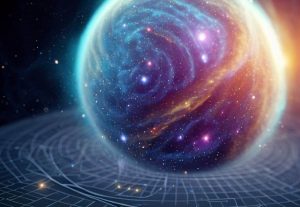Gauging the Size of the Universe

 How big is the universe? This is a question that has fascinated humans for centuries, and one that is still not fully answered.
How big is the universe? This is a question that has fascinated humans for centuries, and one that is still not fully answered.
The universe is the totality of everything that exists, from the smallest subatomic particles to the largest galaxies and beyond. But how can we measure something so vast and mysterious?
One way to approach this question is to consider the observable universe, which is the part of the universe that we can see or detect with our current instruments.

The observable universe is limited by the speed of light, which means that we cannot see anything that is farther away than the distance that light has traveled since the beginning of time.
This distance is called the cosmic horizon, and it is a spherical boundary that surrounds us and defines the edge of our observable universe.
Anything beyond the cosmic horizon is too far away for its light to reach us, and therefore remains invisible to us. The cosmic horizon is about 46.5 billion light-years in any direction from Earth. Therefore, the observable universe has a diameter of about 93 billion light-years.

However, this does not mean that the observable universe is the same as the whole universe. The whole universe may be much larger, or even infinite, but we have no way of knowing for sure.
Some scientists have tried to estimate the size of the whole universe based on various assumptions and models, but these are highly uncertain and speculative. One such estimate, based on a Bayesian analysis of inflationary cosmology, suggests that the whole universe is at least 250 times larger than the observable universe, or at least 7 trillion light-years in diameter .
The size of the universe is also not fixed, but rather expanding. This means that the space between galaxies is stretching over time, making them move away from each other. The rate of this expansion is called the Hubble constant, and it is currently estimated to be about 70 kilometers per second per megaparsec (a megaparsec is 3.26 million light-years).
This means that for every 3.26 million light-years of distance between two galaxies, they are moving away from each other at a speed of 70 kilometers per second. This expansion also affects the cosmic horizon, making it grow larger over time.

How does the universe expand? The expansion of the universe is driven by dark energy, a mysterious form of energy that makes up about 70% of the total energy density of the universe. Dark energy exerts a negative pressure that causes space itself to stretch faster than gravity can pull it together.
The nature and origin of dark energy are still unknown, but one possibility is that it is a cosmological constant, a constant energy density that fills all of space uniformly.
Another possibility is that it is a dynamic scalar field that changes over time and space. The expansion of the universe also depends on other factors, such as the density and composition of matter and radiation, and the curvature of space.

In conclusion, the size of the universe is a complex and intriguing topic that challenges our imagination and understanding. The observable universe is already enormous, but it may be only a tiny fraction of the whole universe, which may be even infinite.
The whole universe is also expanding, making it grow larger over time and creating regions that are inaccessible to us. The question of how big is the universe may never be fully answered, but it will always inspire us to explore and discover more about our cosmic home.




